Peeling Skin On Feet: Causes, Home Remedies, And Prevention
You can deal with flaking skin on the feet efficiently with a few treatments.
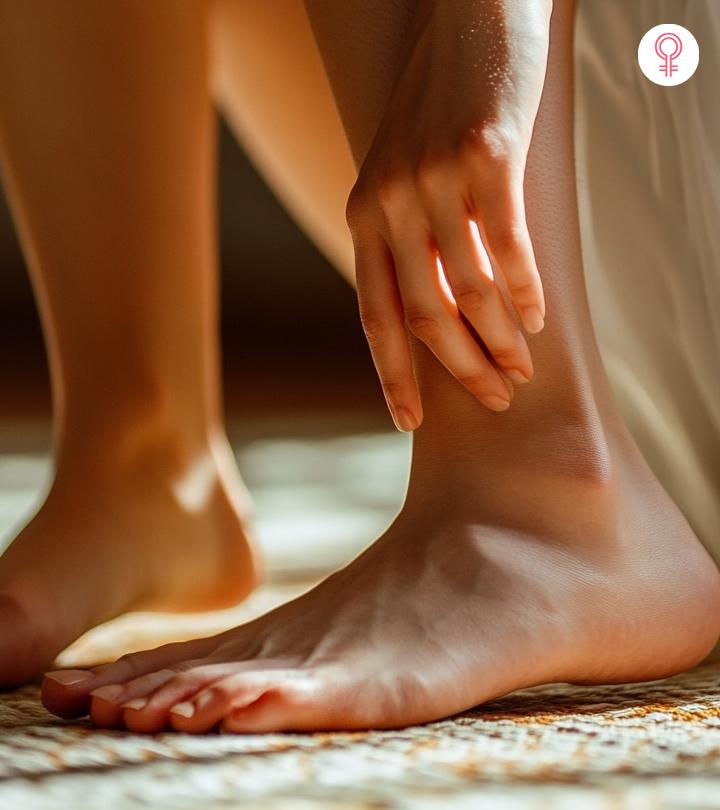
Image: Midjourney/ StyleCraze Design Team
Your feet bear all the wear and tear while rushing around. From peeling skin on feet to developing cracks, they tolerate a lot due to the lack of proper care. It would help keep your feet happy and healthy to avoid these issues. However, skin peeling can also be due to underlying skin conditions that require immediate medical attention. To find out the issue, you need to learn about the different reasons why your skin starts to peel off.
This article will help you learn about the common causes, signs and symptoms, and treatment options available for peeling skin on the feet.
In This Article
Importance Of Addressing Peeling Skin On Feet
It is important to address peeling skin on the feet, as it can create small openings and cracks. These may become potential entry points for bacteria and other pathogens, increasing the risk of infections. Apart from this, it may also cause discomfort and interfere with your daily activities like walking and even wearing shoes. The peeled skin may also lead to itchiness or a burning sensation.
This peeling condition can sometimes be a result of underlying health conditions, and early recognition may prevent complications. The following section will take you through some of the reasons that may be causing peeling skin on your feet.
What Could Be Causing Your Feet To Peel?
Peeling Skin Syndrome (PSS), or the condition of severe skin peeling on feet, is a group of rare inherited skin disorders in which the normal ongoing process of invisible peeling of the outermost skin layer is intensified (1). The characteristic features of this condition include continuous, spontaneous, and painless peeling of the skin that occurs due to the separation of the outermost skin layer from the layers lying below it (2).
1. Genetic Defects
A major cause of peeling skin on feet is genetic defects present in several distinct genes (1).
The genes that cause peeling skin syndrome due to their malfunctioning are TGM5, CHST8, FLG2, CSTA, SERPINB8, and CDSN (3). Other unknown genes may also play a part in the development of this skin condition.
2. Environmental Causes
Apart from the genetic defects, environmental factors also play a role in worsening skin peeling on the feet and toes.
Your feet undergo a lot of strain every day. Right from remaining stuffed inside shoes for long hours to coming in contact with contaminated surfaces, they face several conditions that may trigger excessive skin peeling on feet. Some of the environmental causes that aggravate peeling skin on feet and toes include exposure to heat, friction, humidity, sweat, and other sources of moisture (4). Under such conditions, the skin may temporarily become red and itchy, but they heal without any scarring.
Infographic: Oatmeal Scrub For Treating Peeling Skin On Feet

Illustration: StyleCraze Design Team
Skin peeling on the hands and feet is undesirable, and no one wants to deal with it. But to be able to treat this condition, you must first learn to identify its signs and symptoms. Let us take a look at how you can recognize this skin issue.
Symptoms Of Peeling Feet

Peeling Skin Syndrome is a genetic skin condition that develops at birth or during the early stages of infancy. It starts with the peeling or shedding of the external or outermost layer of the skin (1).
However, the development of symptoms is not limited to birth and early childhood. This means symptoms leading to peeling skin on hands and feet can develop at any age. It can even develop in adults (3). In certain types of this syndrome, the skin peeling takes place without causing any pain or any other symptoms to the individual. But in some other cases, this skin condition is marked by several symptoms. As such, Peeling Skin Syndrome is classified as non-inflammatory (type A) or inflammatory (type B).
The symptoms of this skin condition may vary from individual to individual and range from severe to mild. Some of the common signs and symptoms of peeling skin syndrome include the following:
- Redness of the skin (3)
- Continuous peeling of the outer layer of the skin (3)
- Itching (1)
- Darkening of skin patches (hyperpigmentation) (3)
- Blisters (3)
- Skin fragility (1)
- Burning sensation on the feet
- Formation of new hair that needs less effort to be plucked out than normal hair (1)
- Flare-ups of foot and hand eczema (5)
- Juvenile plantar dermatosis (chronic dry skin on children’s feet) (6)
- Scarlet fever (in case of an acutely unwell child) (7)
- Kawasaki disease (rarely) (8)
Understanding and recognizing these symptoms can help you diagnose and treat the concern in a timely manner. It is also a good idea to keep a note of the intensity of the redness, itchiness, or pain you experience. If it worsens, it is recommended you consult your healthcare provider.
Learn how to fix peeling skin on the feet in the next section.
When And How To Treat Peeling Skin On The Bottom Of Feet
Depending on the severity of your condition, you may take care of your feet through home treatment or opt for medical assistance.
I. At-Home Treatments
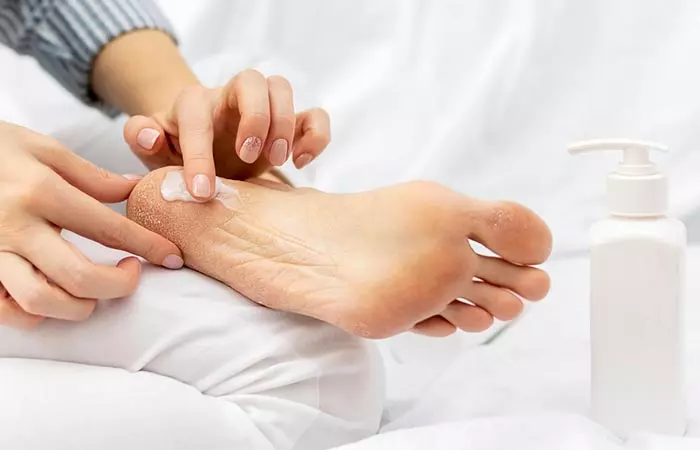
Here are some of the home care procedures that you can follow to keep the skin peeling on your feet under control. These home remedies for cracked heels can soothe and soften rough skin. But, remember that these solutions will work depending on the cause and severity of your condition.
- Keep your feet sufficiently moisturized. You can use a thick moisturizer for this purpose. Look for moisturizers containing ceramidesi Lipid (fat) molecules crucial for the skin's barrier function, preventing loss of moisture and harm from environmental factors. , propylene glycoli A synthetic liquid that absorbs water and is used in a variety of skincare products as a humectant, emollient, solvent, or preservative. , ureai It is used in skincare products as a humectant because of its capacity to soak up moisture from the air and retain it in the skin. , glycolic acidi A type of colorless and odorless chemical compound predominantly derived from sugarcane for a wide range of uses in skin and healthcare. , and lactic acidi A colorless to yellow and odorless compound produced in the muscle and red blood cells that helps remove dead skin cells from the epidermis. .
- If you have athlete’s foot (fungal infection on the feet), you can apply an over-the-counter antifungal cream to get relief. If you experience no relief in 3-4 weeks, consult a dermatologist.
- In the case of blisters, ensure to cover them and keep them dry and clean. You can use Band-Aids for this purpose.
- Avoid wearing shoes if you feel that it will create friction with the blisters.
- Try to keep your feet dry and clean as much as possible.
- Do not risk walking barefoot on any surface that may be contaminated.
- Wear socks or slippers at home.
- If your feet develop calluses, consult a dermatologist and get it treated.
- Apply an oatmeal scrub to remove dead skin on your feet.
- Try out this homemade foot soak recipe. For this make a solution of Epsom salt and water, then gently brush off the dead cells using a foot brush or pumice stone.
- Try to keep an eye on what triggers the skin condition.
- Keep your feet away from harsh detergents or harsh cleansers.
If your skin condition worsens even after following these at-home preventative measures and self-care tips, consult a dermatologist. A professional evaluation can help rule out any underlying condition so that you can take the required treatment. You can learn about this medical evaluation below.
 Quick Tip
Quick TipII. Medical Treatments
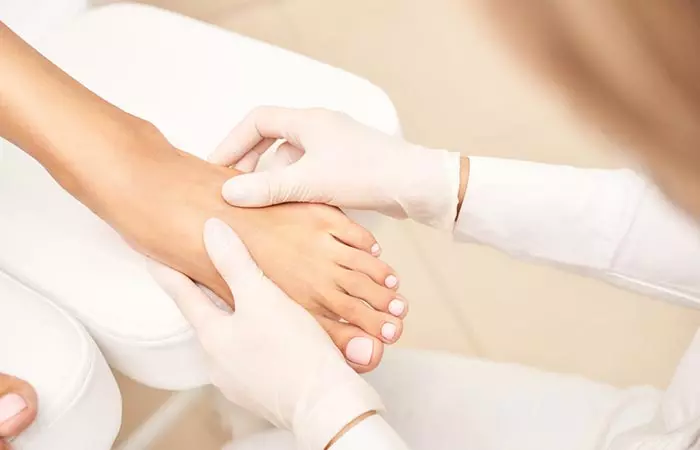
When you opt for medical treatment to deal with dry peeling skin on your feet, it will involve a two-step procedure. The first step is a medical diagnosis of the skin condition, and the second step is an appropriate course of action for treatment.
- Diagnosis
Generally, Peeling Skin Syndrome is diagnosed with the help of scrutiny of the symptoms and clinical examinations. Sometimes, specialized tests may also be required to evaluate the condition. SSuch tests help to distinguish PSS from other skin issues, such as Netherton syndrome.
 Did You Know?
Did You Know?- Standard Therapies
The main focus of treating this skin syndrome is the management of the symptoms. The aim is to avoid skin damage while providing relief from the symptoms. The common method followed for treating this skin condition is to apply skin softening ointments. These ointments are often prescribed to be applied after a bath when the skin is still moist. Vaseline and plain petroleum jelly are also recommended for treating this condition. Along with these, individuals are also asked to avoid triggers that may aggravate the issue, such as heat, humidity, sweat, water, and other factors.
You may seek professional guidance from a dermatologist to deal with this issue.
Besides PSS, your skin could also be peeling due to some other reasons. Learn all about them in the next section.
Other Reasons Your Feet Are Peeling And How To Fix Them
If your feet have suddenly started peeling, you need to explore the root cause of the issue before taking any remedial steps. Here are some of the common reasons your feet may be peeling excessively:
1. Fungal Infections
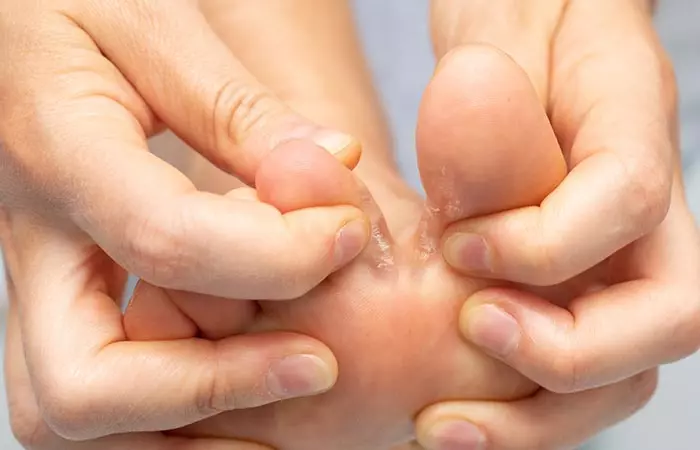
A fungal infection can cause your feet to peel (9). For instance, if you have athlete’s foot, you may just be experiencing peeling of the skin but no itchiness. As such, you may not even doubt that it is a fungal infection.
Consult a dermatologist to treat the infection as it recurs if not treated appropriately and is contagious.
2. Dry Skin
A major cause of your feet feeling flaky and itchy could be dryness
. Yes, if your feet are excessively dry and lack natural oils, it can lead to such skin problems. You may also experience cracked and peeling soles. This is an indication to take good care of your skin in general and your feet in particular.
A good foot cream with excellent moisturizing properties can help you out in this case by reducing the cracking of dry skin. You can also visit a dry skin care specialist to get your feet treated properly.
3. Sunburn
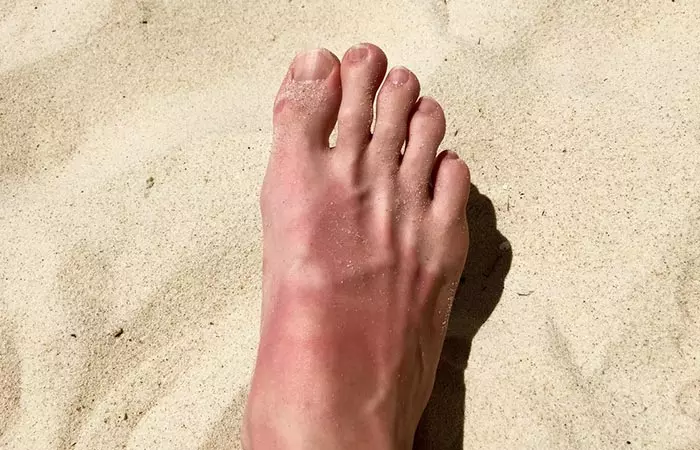
Most people remember to apply sunscreen on their faces and hands when stepping out. But, their feet are often forgotten in such cases. Exposing your feet to the harsh rays of the sun may cause itching and uncontrollable peeling.
To overcome this issue, you can apply an aloe vera-based lotion to soothe your skin and get relief from the itching. You can also apply a moisturizing cream to reduce the peeling. Always use a sunscreen.
4. Humid Workout Sessions
Sometimes, foot infections and peeling of skin can develop when you spend a considerable amount of time in a humid environment, such as a gym. On top of that, if you work out barefoot or share the same yoga mat with someone else, your feet may catch a fungal or bacterial infection.
To steer clear of such issues, wear socks that wick away sweat and absorb moisture. Also, try to keep your feet clean and sweat-free at all times.
5. Eczema
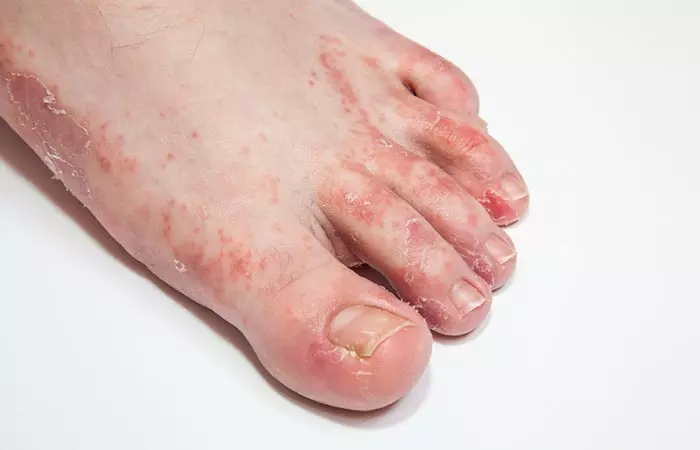
Eczema is a chronic inflammatory skin condition that can cause your feet to become red, dry, and itchy. This can lead to the development of warts and sores along with peeling of the skin.
This graph presents some of the most common symptoms of eczema and by what percentage they affect people worldwide. Peeling or flaking skin is one of the top ten symptoms of eczema, affecting 19% of global respondents in this statistic.

Worst Eczema Symptoms As Experienced By Patients Worldwide
Source: Percentage of global respondents who reported select eczema symptoms as being most problematic as of 2019In such a case, you must consult a dermatologist to get proper treatment.
 Trivia
Trivia6. Psoriasis
Psoriasis is a chronic inflammatory skin condition that causes the skin to become red, dry, patchy, and scaly
. It may also cause the skin on your feet to peel.
This inflammatory skin condition requires proper treatment to get rid of the scaly and dry plaques and to reduce the skin peeling. It is best to seek medical help to treat this skin problem.
7. Aging
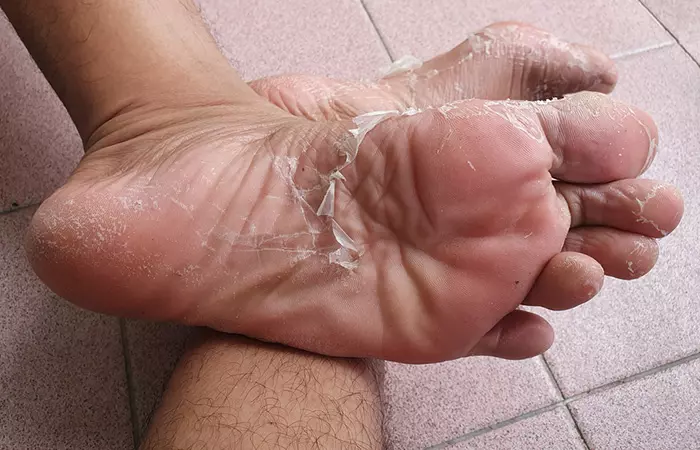
With aging, there is a gradual decrease in the production of collagen in the skin, which makes it dry and brittle. This may lead to peeling skin on the feet as well as flaky spots. The skin also becomes thinner as a result of collagen decline, which makes it more prone to damage.
8. Hyperhidrosis
Hyperhidrosis is a chronic skin condition that causes excessive sweating, which may not always result from heat or exercise. This may affect just one area or the entire body. The condition also commonly affects the sole of the feet, causing redness, inflammation, irritation, and softening of the skin, which may result in peeling of the skin on the feet (10).
Check out the next section to learn when to see a doctor.
When To See A Doctor
While peeling skin on the soles and feet usually does not cause any pain, sometimes the issue can turn into a major cause of concern. You need to consult a doctor if you experience one or more of the issues mentioned below:
- Numbness or pain in the feet.
- The symptoms persist for a long time.
- One or both of your feet develop acute pain that causes trouble when you walk.
- Symptoms of infection of any kind, including fever.
- An external object, such as a piece of wood or glass, is stuck in your foot.
- You suffered an injury to your foot by stepping on something sharp and have not taken a shot of tetanus recently.
- You suspect you have psoriasis.
Peeling skin on the feet is a telltale sign of a deeper problem. It can strike anyone at any age. The signs and symptoms of this skin ailment vary from person to person and could be severe or moderate. Genetic defects or environmental factors like heat, sweat, and friction can cause skin peeling. Instead of ignoring the problem, you should investigate the root cause. After that, you can seek medical assistance or try home treatments to resolve the issue. You can easily control the skin peeling on your feet and gain relief if you take the right steps at the right time. You can also indulge in some rejuvenating foot care with a nice pedicure or a foot spa session.
Frequently Asked Questions
Does lack of vitamin D cause skin peeling?
Dr. Rebecca Marcus, MD, FAAD, a board-certified dermatologist, says, “Vitamin D plays a role in skin hydration. Vitamin D also has antioxidant and anti-inflammatory properties that help protect cells. If the skin becomes dry due to vitamin D deficiency or otherwise, yes, it may peel.”
Can stress cause the skin to peel off?
Dr. Marcus says, “Stress in itself is unlikely to cause the skin to peel. However, it may trigger a flare-up of a pre-existing inflammatory skin disorder, such as eczema, which may then cause the skin to peel.”
Can B12 deficiency cause peeling skin?
Vitamin B12 deficiency most often manifests in the skin as hyperpigmentation. Dr. Marcus adds, “It can also sometimes be associated with angular cheilitis, which can cause peeling of the skin at the outer corners of the mouth.”
Does diabetes make your feet peel?
Yes, diabetes may result in skin manifestations like dry, thick, and scaly skin. Consult your doctor for further information and treatment (11), (12).
Do foot peel socks work?
Anecdotal evidence suggests that exfoliating socks may work. This is because these socks contain chemical solutions like glycolic acidi A type of colorless and odorless chemical compound predominantly derived from sugarcane for a wide range of uses in skin and healthcare. help in deep exfoliation, removing dead skin, leaving your feet soft and healthy. It may take a few days before you see visible results. However, if you have skin conditions like psoriasis or eczema, consult your doctor before using these socks.
What happens if you leave a foot peel on too long?
Leaving a foot peel on for too long may result in an allergic reaction. Ensure that you follow the label instructions to avoid this.
How long does foot peel last?
A foot peel commonly lasts between a week to two weeks to allow your skin to peel completely. However, the time may vary from person to person.
Key Takeaways
- An inherited disorder called peeling skin syndrome, genetic defects, or environmental factors can cause peeling of the foot skin.
- Painless shedding is common. However, redness and itching are observed in some individuals.
- Moisturizing your feet, keeping them dry and clean, scrubbing, and soaking feet in Epsom salt can control the condition.
- If the peeling is severe, medical treatments and therapies can help.
Learn about the causes of skin peeling on hands and feet with this informative video. Check it out to get tips on how to prevent and treat this common skin condition.
References
Articles on StyleCraze are backed by verified information from peer-reviewed and academic research papers, reputed organizations, research institutions, and medical associations to ensure accuracy and relevance. Read our editorial policy to learn more.
- Peeling Skin Syndrome
https://rarediseases.org/rare-diseases/peeling-skin-syndrome/ - Acral peeling skin syndrome
https://pubmed.ncbi.nlm.nih.gov/11100033/ - Peeling Skin Syndrome
https://rarediseases.info.nih.gov/diseases/7347/peeling-skin-syndrome - A Case of Late-Onset Peeling Skin Syndrome Likely Triggered by Irritation
https://www.ncbi.nlm.nih.gov/pmc/articles/PMC5318512/ - Acral peeling skin syndrome: An underdiagnosed skin disorder
https://www.researchgate.net/publication/330622510_Acral_peeling_skin_syndrome_An_underdiagnosed_skin_disorder - Juvenile plantar dermatosis treated with homoeopathic remedy ”Petroleum”-a case study
https://www.researchgate.net/publication/368365330_Juvenile_plantar_dermatosis_treated_with_homoeopathic_remedy_Petroleum-a_case_study - Palmoplantar exfoliation due to chloroquine
https://www.ncbi.nlm.nih.gov/pmc/articles/PMC5497445/ - Desquamation In Kawasaki Disease And Its Relationship With Coronary Artery Abnormalities
https://www.researchgate.net/publication/341034871_Desquamation_In_Kawasaki_Disease_And_Its_Relationship_With_Coronary_Artery_Abnormalities/fulltext/5eaa34cd299bf18b9587cf71/Desquamation-In-Kawasaki-Disease-And-Its-Relationship-With-Coronary-Artery-Abnormalities.pdf - Topical treatments for fungal infections of the skin and nails of the foot.
https://www.ncbi.nlm.nih.gov/pmc/articles/PMC7073424/ - Hyperhidrosis and its impact on those living with it
https://pubmed.ncbi.nlm.nih.gov/30589248/ - Skin Manifestations of Diabetes Mellitus
https://www.ncbi.nlm.nih.gov/books/NBK481900/ - Diabetes mellitus and the skin
https://www.researchgate.net/publication/314152515_Diabetes_mellitus_and_the_skin
Read full bio of Dr. Saloni Vora-Gala
- Dr. Rebecca Marcus, MD, FAAD, is a board-certified dermatologist with 13 years of experience in medical, surgical, and cosmetic dermatology. She graduated from the University of Minnesota and did a clinical research fellowship at Columbia University.
 Dr. Rebecca Marcus, MD, FAAD, is a board-certified dermatologist with 13 years of experience in medical, surgical, and cosmetic dermatology. She graduated from the University of Minnesota and did a clinical research fellowship at Columbia University.
Dr. Rebecca Marcus, MD, FAAD, is a board-certified dermatologist with 13 years of experience in medical, surgical, and cosmetic dermatology. She graduated from the University of Minnesota and did a clinical research fellowship at Columbia University.
Read full bio of Ramona Sinha
Read full bio of Swathi E





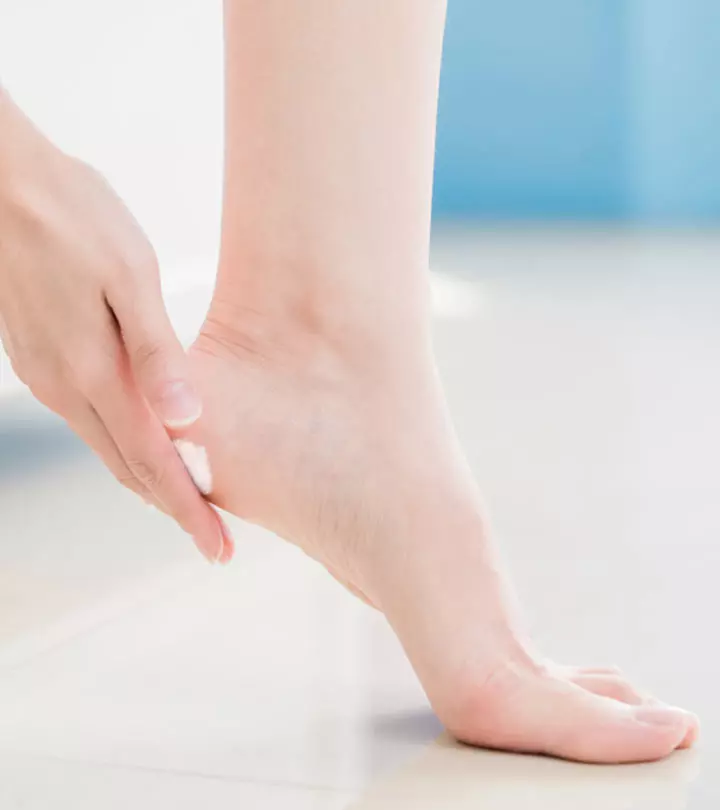
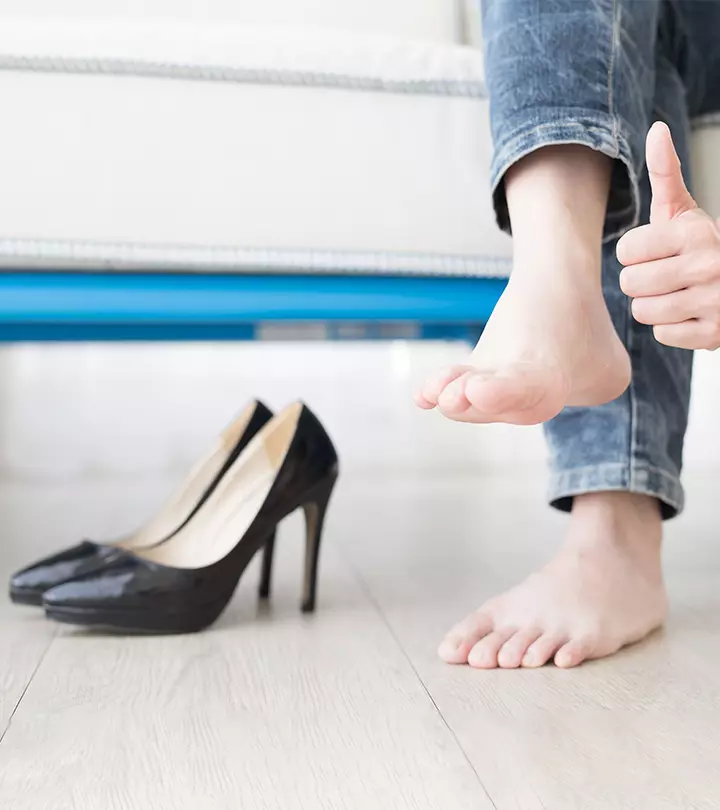
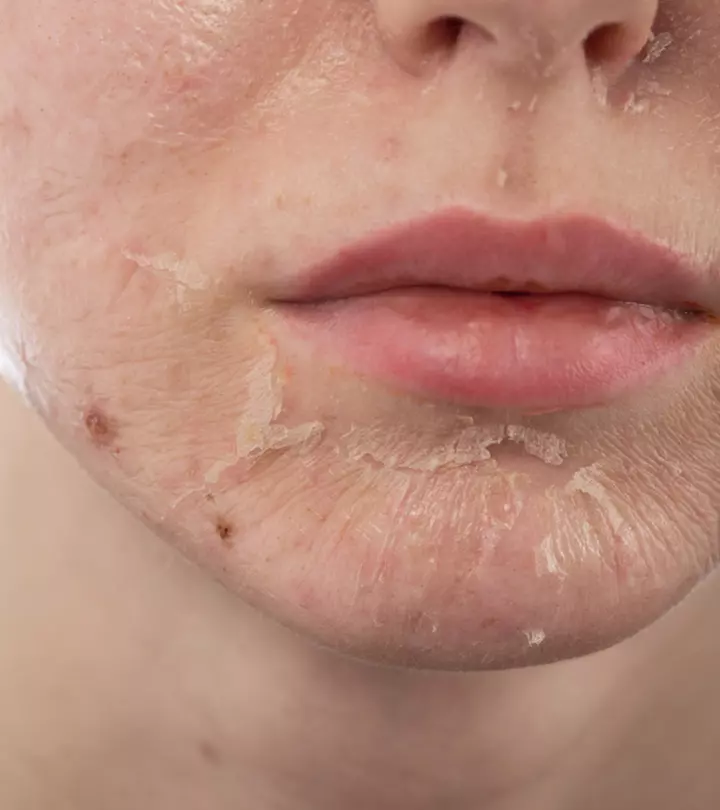

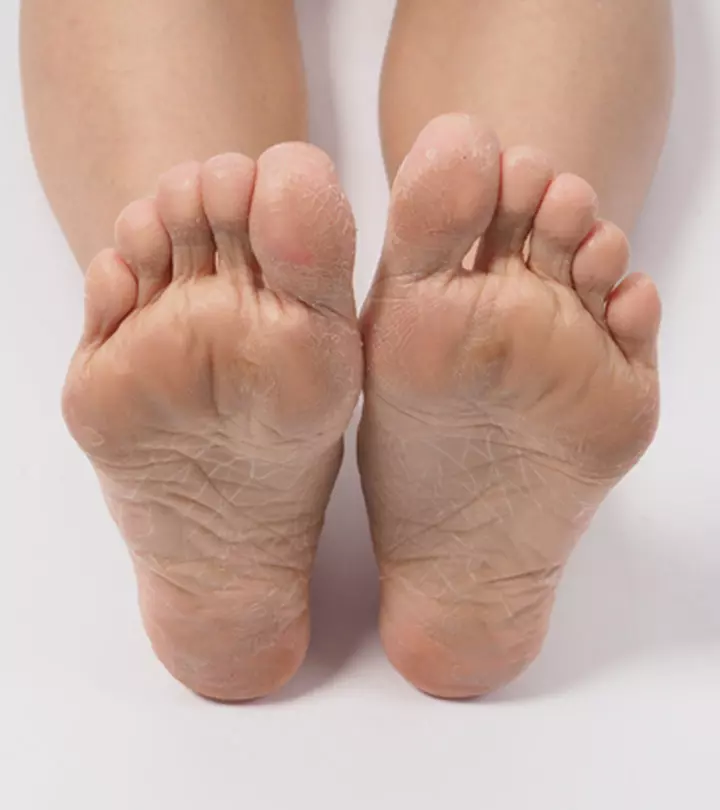
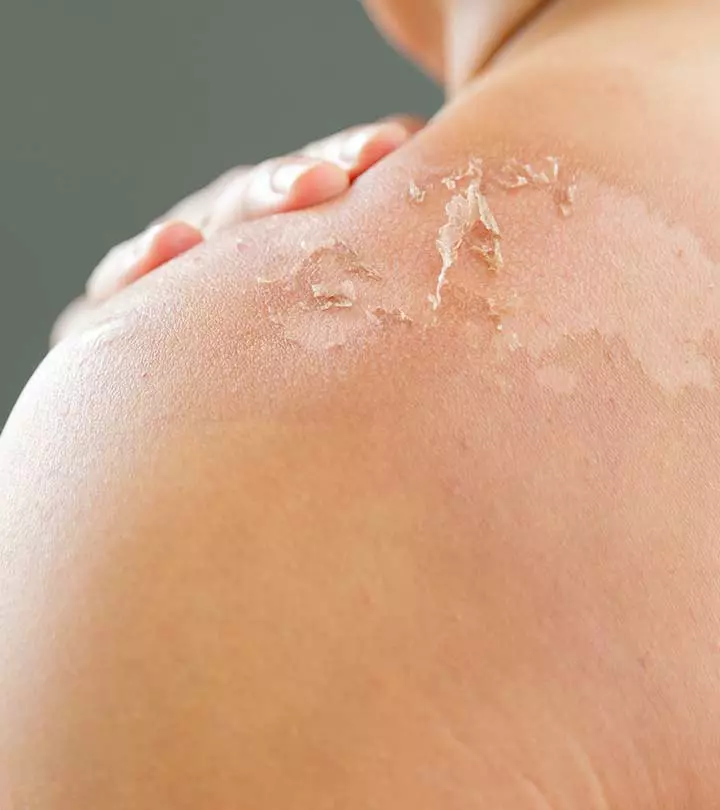
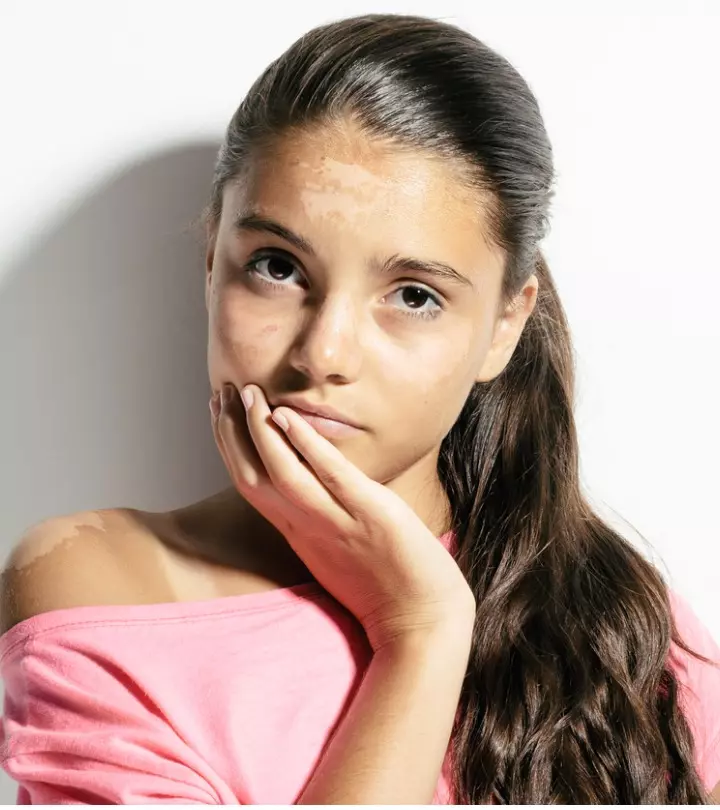
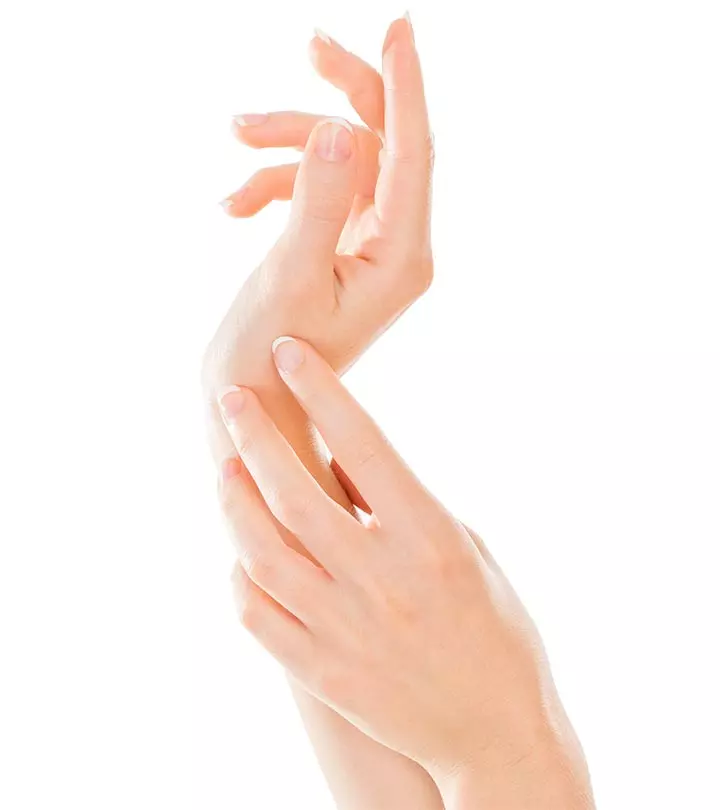

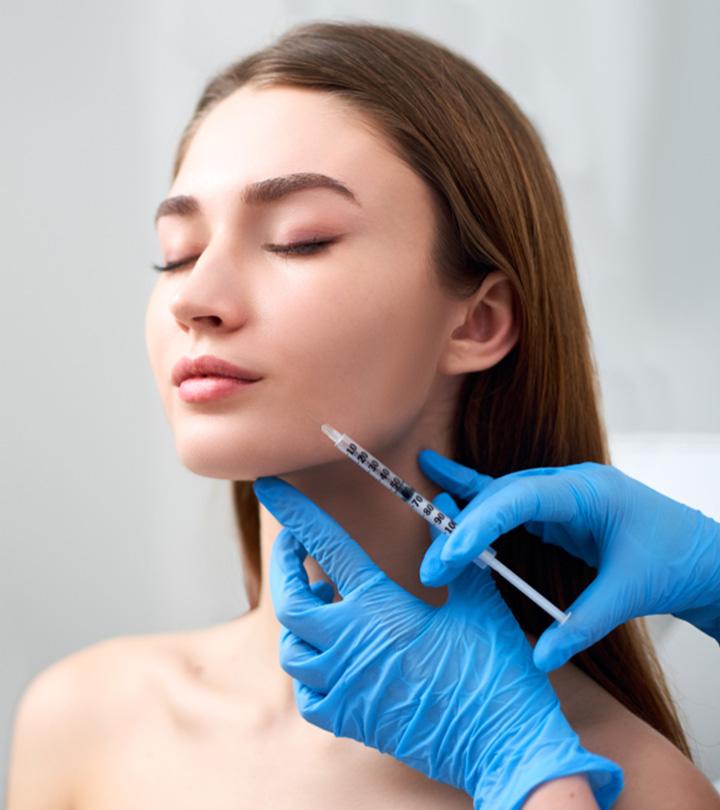
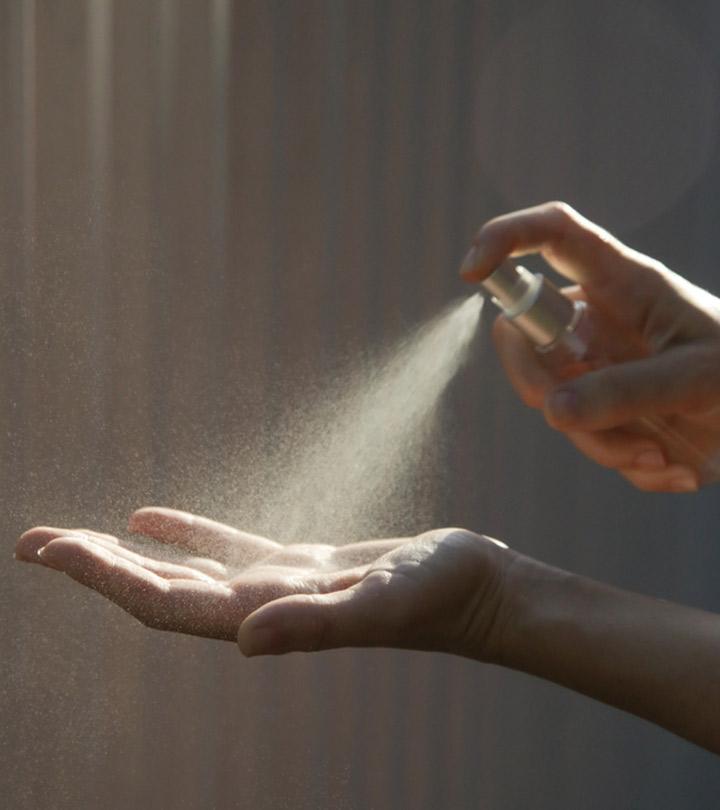

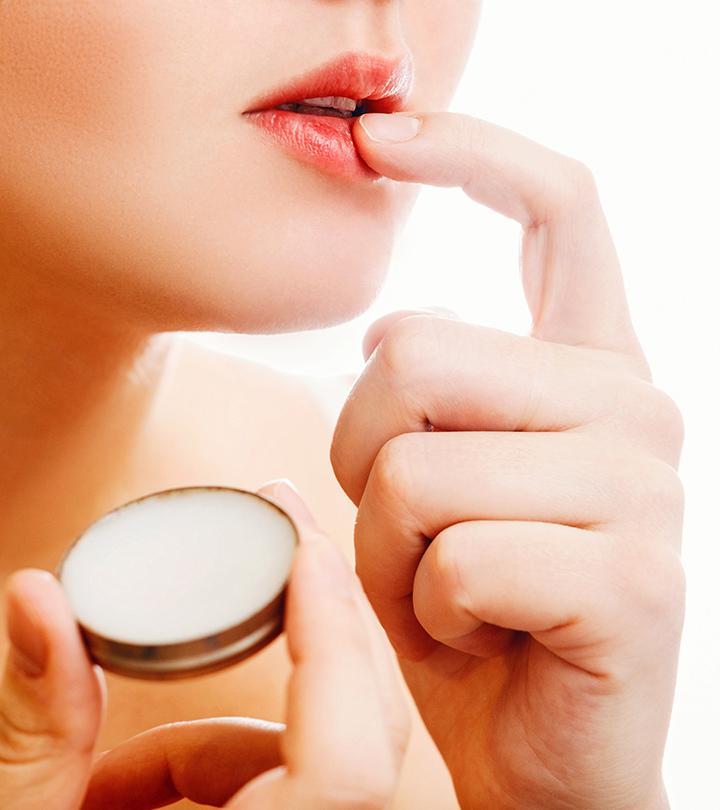
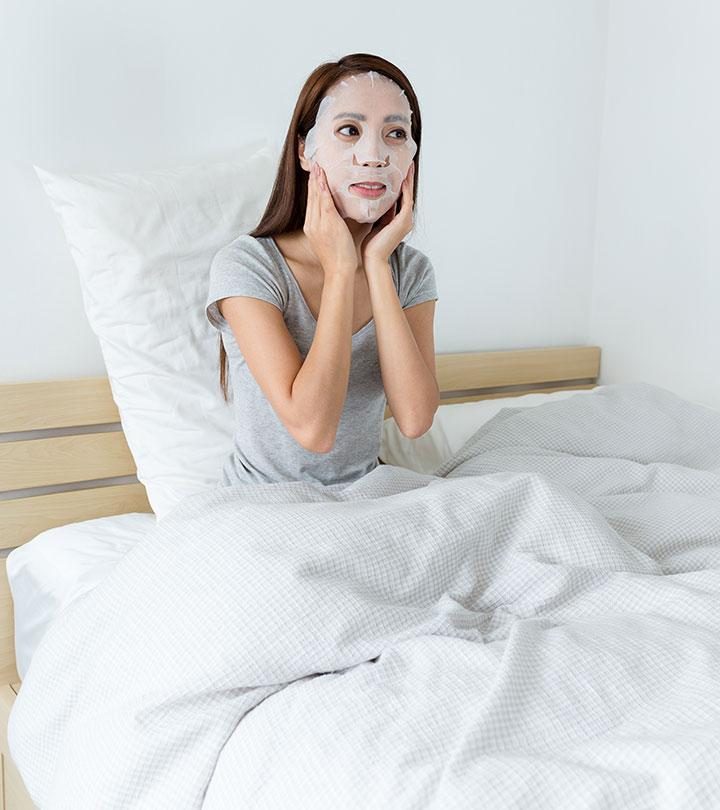
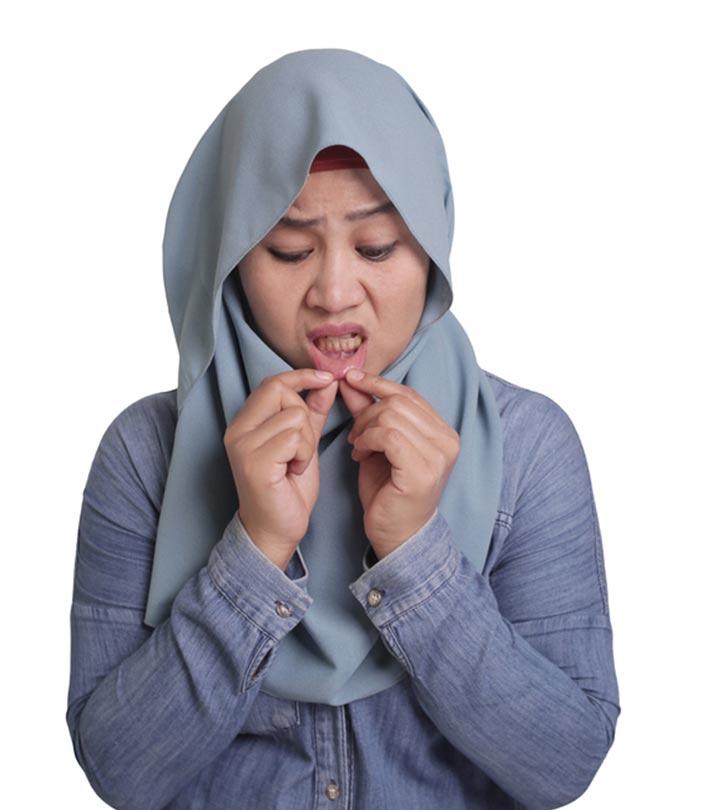

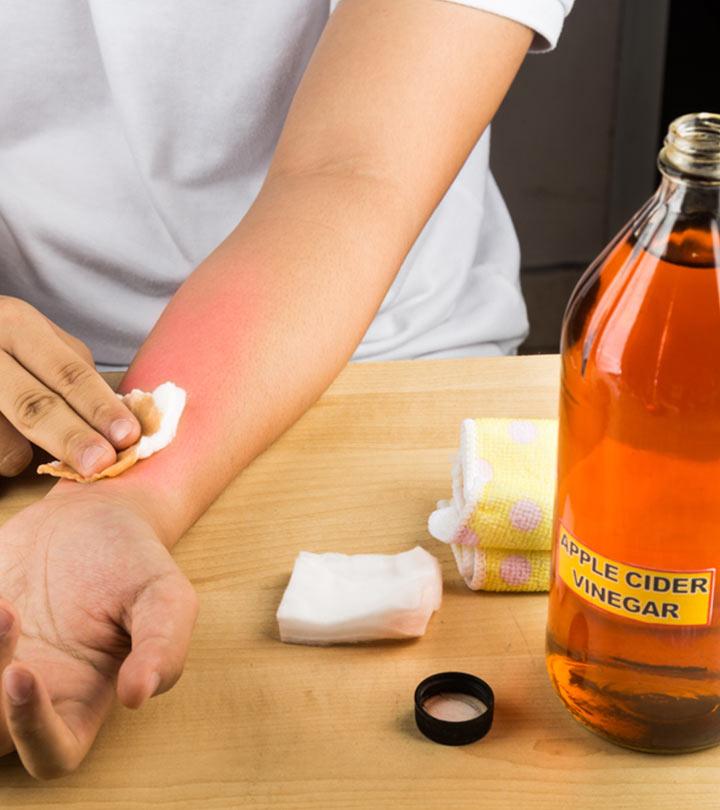

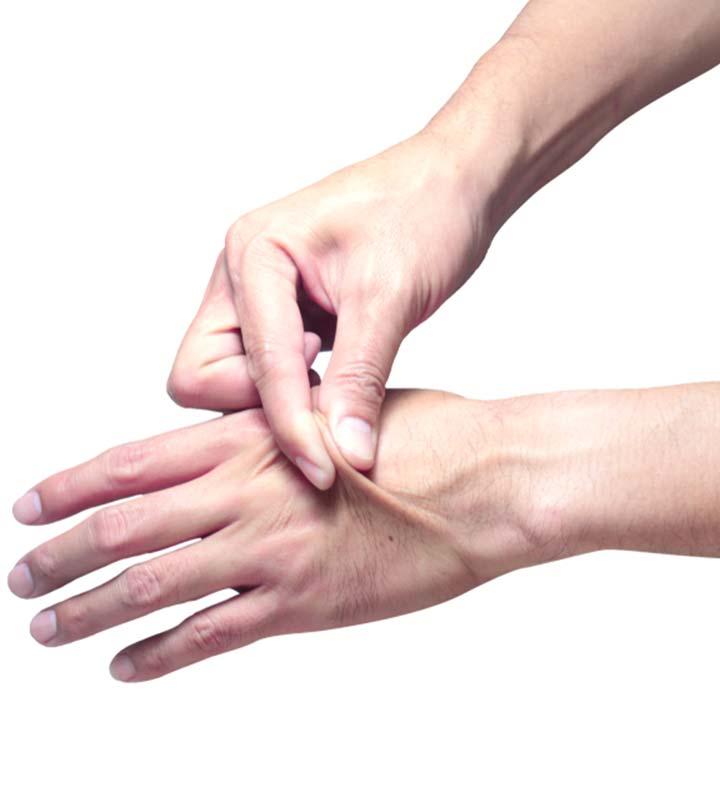


Community Experiences
Join the conversation and become a part of our empowering community! Share your stories, experiences, and insights to connect with other beauty, lifestyle, and health enthusiasts.